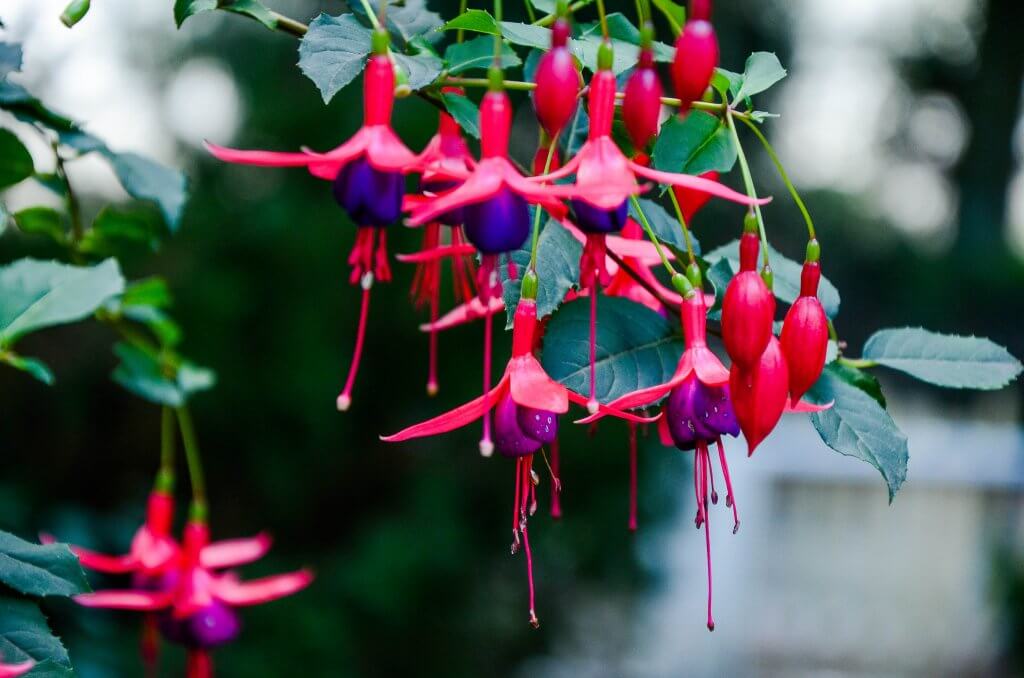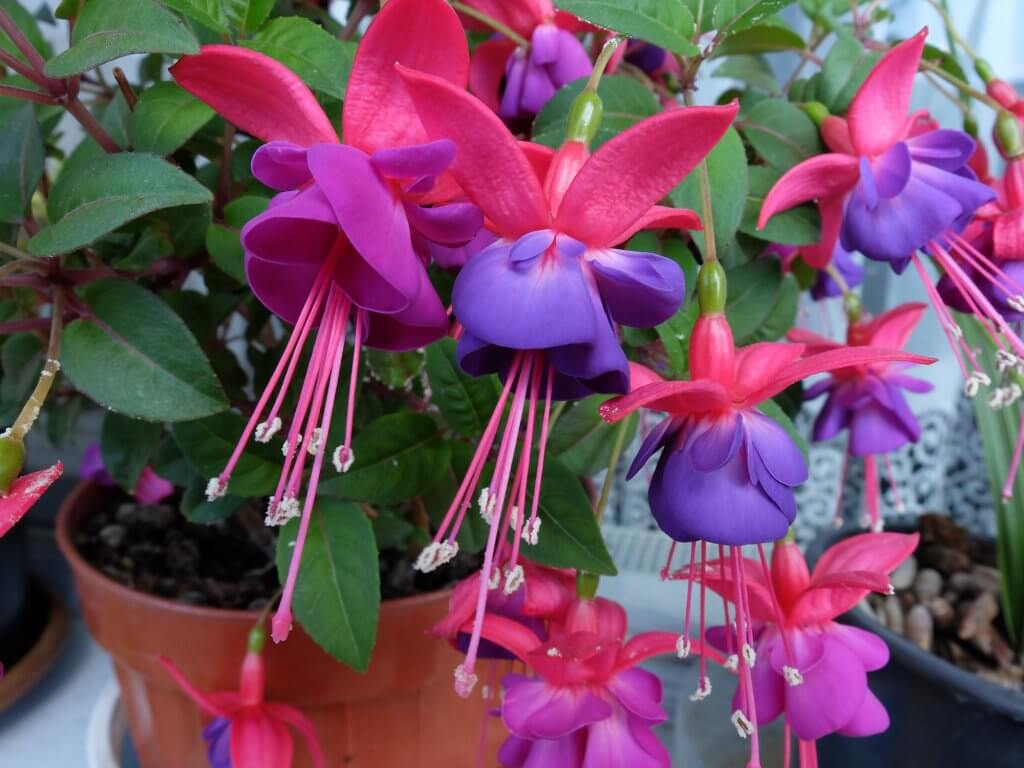A gorgeous two-tone flower, Fuchsia is a favorite accent piece to virtually any garden. Fuchsia can be planted in hanging planters, garden beds, and raised containers. Fuchsia can be a little light-sensitive, and pest sensitive as well. But, if you take proper care of your Fuchsia, it will continue to blossom and grow throughout the summer months. It is definitely a favorite of the Harwood’s Garden Supplies team.

Choosing Your Fuchsia
There are over a hundred species of Fuchsia available today, with thousands of potential varieties that can be cultivated. You may have some very unique and distinct varieties available to you. Here’s an overview of some of the most common species of Fuchsia and what makes them special. Finding a variety of one of these species will give you a more predictable growing experience.
- Boliviana Fuchsia. Lengthy, drooping blossoms in bright red make the Boliviana Fuchsia showy and intense. They grow well in zones 3 to 4.
- Dollar Princess. With thick pink and purple blossoms, the Dollar Princess is extremely attractive and eye-catching. They can grow in sun or shade, and thrive from zones 1 to 5.
- Fulgens Fuchsia. Bright red or pink blooms make this Fuchsia particularly showy. The Fulgens Fuchsia can grow up to 4 to 5 feet tall, blooms most of the year, and even produces edible fruit.
- Hardy Fuchsia. Gorgeous pink blossoms with purple interiors are the showcase of this Fuchsia, which can grow to two to three feet in height. Hardy in zones 1 and 4, this Fuchsia is good for those who want a plant that’s going to be able to thrive outdoors.
- Paniculata Fuchsia. This Fuchsia has delicate, bell-shaped flowers that range from pink to white, and that will grow in zones 2 to 5. Like the Fulgens, it produces edible fruit.
- Tree Fuchsia. A rarer Fuchsia, the Tree Fuchsia only grows well in zones 3 to 4, but when given warmth it produces delicate, lilac flowers which then burst into a hot pink.
When thinking about choosing your Fuchsia, think about where it’s going to go, how large you want it to get, and what you want its flowers to look like. All this will tell you exactly what you want in your new plant.


Where to Buy
If you are looking to buy a Fuchsia, we suggest you check out our friends at Garden Express. Garden Express have a massive variety of Fuchsias available that you can order online also delivery is from $9.90 Australia Wide. (Addition charges may apply for specific states and size of orders.) More delivery information here.
Do you live in Hobart Tasmania? Check out our preferred local plant supplier Greenhill Nursery. They have a fantastic selection of Fuchsias available.
Planting Your Fuchsia
Find a location for your Fuchsia that gets at least partial shade. Fuchsia will want some sun, but not full sun; it’s temperamental when it comes to temperatures and prefers cooler locations.
When planting into the ground, plant Fuchsia so that the stem is 2 inches below the soil. When planting in a container, choose a container that the Fuchsia can grow into without getting root bound, and without drying out too frequently.
Most Fuchsia are not hardy and so will be planted in a container. But there are some hardy breeds.


Caring for Your Fuchsia
Inspect your Fuchsia regularly for pests. Don’t overwater, as the roots may rot, but do keep the soil moist. If the soil isn’t kept moist, the Fuchsia will not blossom as much as it can. When winter approaches, hardy Fuchsia should have mulch placed over them, to protect them from the worst of the frost.
You should fertilise your Fuchsia every two weeks, except for late summer. Start to pull back on fertiliser in the late summer months and throughout autumn, because your Fuchsia will be preparing to go dormant during the winter.
While there are some areas in which Fuchsias can be hardy, it’s usually better to keep Fuchsias in a container and move them in during the winter. This protects them from the frost and keeps them growing all year long.
Most Fuchsias don’t need a lot of sunshine. Take a look at your leaves. If they are burning, your Fuchsia needs more shade. If your plant is growing slowly, it may need a little more sun. Regardless, most Fuchsia don’t like very warm environments. Keep them in a cooler space, especially if they are in a container; container plants tend to dry out fast.
Prune Fuchsias during spring, cutting back the stems before the new growth sets in. You can also grow Fuchsias as standards with a little additional pruning, which greatly increases their appearance.


Common Problems With Fuchsias
The right Fuchsia can grow hardy in many regions, but most Fuchsia do need to be protected from the colder winter weather. There are also some other common issues that Fuchsia might experience, though Fuchsia can be surprisingly resilient when well-cared for:
- Tomato spotted wilt. If you start seeing spots and wilt around your Fuchsia, it’s potentially a viral disease. You may also see twisted leaves, necrotic spots, and viral growth. Wilt and other viral diseases cannot be healed within a plant. The affected plants are going to need to be destroyed entirely and replaced.
- Rust. Orange spots on the leaves of your Fuchsia mean that a fungal infection has taken over. Unlike a virus, a fungal infection can be treated with anti-fungicide, as well as cutting back any of the leaves, flowers, and stems that have been affected.
- Rot. If the roots and stems of your Fuchsias have become rotted, then you may need to cut back the plant or remove it entirely. This can happen frequently with Fuchsias and other container plants, if the containers are not draining well enough. Consider moving the plant to a better draining location.
- Pests. If there are holes emerging in your Fuchsia’s leaves, it’s likely pests. Treat by introducing predators (such as ladybugs) or using natural pest control. Pests usually don’t damage the overall health of the plant but can heavily distract from its appearance.
There are few flowering plants quite as beautiful and dramatic as the Fuchsia. The Fuchsia produces blossoms that are like no other. Not only are they delicate and complex, but they are two-toned and vibrant. Many of them come in bright colours like purples and pinks, and they are sure to be a show-stopper in any garden.


But there are also some things you need to consider. They can look delicate because they often are delicate. They are better planted in zones from 3 to 5, or as container plants. They thrive as container plants, even when they are hardy because they can be protected from the worst of the weather. Fuchsias should be watered frequently and also fertilised frequently, and aren’t a good plant for those who want a completely low maintenance garden.
[elementor-template id=”4604″]
[elementor-template id=”6387″]
